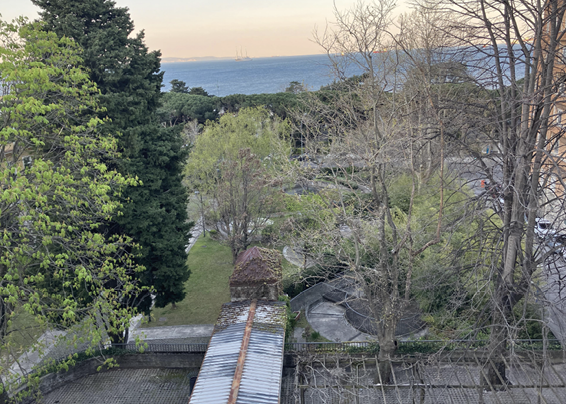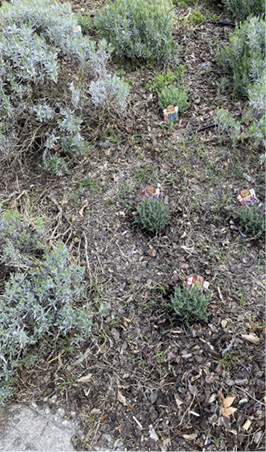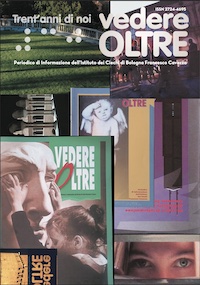In Barcola, a village near Trieste, there is an enchanted garden created to stimulate all five of the senses. Protected by a thick stone wall, the sensory garden extends from viale Miramare to the imposing villa that Baroness Cecilia da Rittmeyer donated in 1913 to create an institute dedicated to teaching the blind. The public garden stretches over several levels linked by majestic stairs along the slope that climbs from the sea toward the Karst plateau. This unique arrangement guarantees that from practically every point of the park, looking southwest, you can see beyond the wall to the Barcola marina and then to the stretch of sea where the world’s largest sailing race takes place in October. The stairs shouldn’t frighten the sight-impaired because they are always protected by barriers and gates, and people with limited mobility are helped by a well-designed system of ramps and elevators.The garden’s lowest level has numerous tall-trunk trees: domestic pines, cypresses, and a weeping willow planted near a spring.

But the bright, dark, or silver foliage of the trees aren’t the only colors in the large garden: there are specific flowerbeds with yellow, blue, red, and violet flowers that form a living palette that changes with the seasons. From March to November, the Rittmeyer garden is punctuated with splashes of brilliant flowers that bloom in sequence and, when there are no flowers, there are winter berries, such as the pink ones on the tops of the yew branches pruned to hedges.
But the flowers don’t stimulate sight alone: many reach the visitor’s nose with fragrant nectar, and so the sight-impaired can enjoy a vivid sensory experience by visiting the Rittmeyer garden.
-min.png) In addition, a large, multilevel flowerbed is filled with aromatic plants such as lavender, rosemary, mint, thyme, marjoram, and many others, which release their aromas when brushed by the hand. There are many other plants within reach, so the visitor’s sense of touch can be stimulated by the scaly bark of pines or by the rough bark of the willow, by the soft, needle-shaped leaves of the yew, by the velvety surface of the sage leaf or the rougher surface of the fig leaf. The sight-impaired can walk relatively safely through the park because the borders of the paths are paved in cobblestones which, when stepped on, prevent tripping into the flowerbeds. It is the forerunner of modern tactile paving. To stimulate the tastebuds, just go to the restaurants, coffee shops, and ice cream stands on the path running along the coast, just outside the park. Moreover, in the highest part of the garden, reached through a corridor of the sheltered accommodation in the Rittmeyer villa, the guests cultivate a small garden at ground level and on raised surfaces reachable from a wheelchair, and after the numerous trees have ended their decorative flowering stage, they produce delicious fruit. Lastly, the park stimulates the sense of hearing, and one reference point is certainly the small artificial stream that is kept flowing in the summer. During the day, it’s easy to hear the gentle call of the dove and the scream of gulls, while at night there is always the rhythmic “kiew” of a small scops owl, marking off its hunting territory.
In addition, a large, multilevel flowerbed is filled with aromatic plants such as lavender, rosemary, mint, thyme, marjoram, and many others, which release their aromas when brushed by the hand. There are many other plants within reach, so the visitor’s sense of touch can be stimulated by the scaly bark of pines or by the rough bark of the willow, by the soft, needle-shaped leaves of the yew, by the velvety surface of the sage leaf or the rougher surface of the fig leaf. The sight-impaired can walk relatively safely through the park because the borders of the paths are paved in cobblestones which, when stepped on, prevent tripping into the flowerbeds. It is the forerunner of modern tactile paving. To stimulate the tastebuds, just go to the restaurants, coffee shops, and ice cream stands on the path running along the coast, just outside the park. Moreover, in the highest part of the garden, reached through a corridor of the sheltered accommodation in the Rittmeyer villa, the guests cultivate a small garden at ground level and on raised surfaces reachable from a wheelchair, and after the numerous trees have ended their decorative flowering stage, they produce delicious fruit. Lastly, the park stimulates the sense of hearing, and one reference point is certainly the small artificial stream that is kept flowing in the summer. During the day, it’s easy to hear the gentle call of the dove and the scream of gulls, while at night there is always the rhythmic “kiew” of a small scops owl, marking off its hunting territory.
 The sea breeze very often participates in the Rittmeyer park concert, gently rustling the treetops. But if the wind comes from the northeast, then it’s the bora and can become violent: animals are silent, branches start to knock against each other, and the stays of the boats anchored in the nearby marina begin to emit a sinister whistle. On days like that, it’s better to enjoy the panorama behind the windows of the residence or of the daytime leisure center of the Rittmeyer Regional Institute for the Blind, now managed by the Autonomous Region of Friuli Venezia Giulia. Here, healthcare workers, teachers, and volunteers organize a wide range of activities for the guests of the sheltered accommodation, from garden therapy to the packaging of foodstuffs and aromatic products from the garden. The structure may also serve as a brief stopover in Trieste for people traveling on their own by train and taxi but require a little help in managing their overnight stay.
The sea breeze very often participates in the Rittmeyer park concert, gently rustling the treetops. But if the wind comes from the northeast, then it’s the bora and can become violent: animals are silent, branches start to knock against each other, and the stays of the boats anchored in the nearby marina begin to emit a sinister whistle. On days like that, it’s better to enjoy the panorama behind the windows of the residence or of the daytime leisure center of the Rittmeyer Regional Institute for the Blind, now managed by the Autonomous Region of Friuli Venezia Giulia. Here, healthcare workers, teachers, and volunteers organize a wide range of activities for the guests of the sheltered accommodation, from garden therapy to the packaging of foodstuffs and aromatic products from the garden. The structure may also serve as a brief stopover in Trieste for people traveling on their own by train and taxi but require a little help in managing their overnight stay.





.png)